Re-Staking Wars: Do We Really Need So Many Re-Staking Players?

Reprinted from jinse
01/02/2025·4MAuthor: Donovan Choy, crypto analyst; Translated by: Golden Finance xiaozou
1. Introduction
The restaking war is heating up. Challenging EigenLayer’s monopoly is another new protocol, Symbiotic, powered by Lido. The latest entrants have competitive advantages in protocol design and BD partnerships. Before we delve into the latest competitive dynamics in the rehypothecation space, we need to first understand what key risks exist in the space.
2. Current issues with re-pledge
Today, restaking works like this: Bob deposits ETH/stETH into a liquidity restaking protocol like Ether.Fi, Renzo, or Swell, delegates it to an EigenLayer node operator, and that operator secures One or more AVS returns part of the proceeds to Bob.
There is a compounding risk in the current situation that lies in its one- size-fits-all nature. EigenLayer node operators handle thousands of assets for validating multiple AVS. This means that Bob has no say in the management of potential risks associated with which AVS the node operator chooses.
Sure, Bob could try to choose a "more secure" node operator, but there are hundreds of operators competing with each other to get your re-staking collateral, and are all incentivized to verify as much as possible AVS, maximize your profits.
Taking a quick look at the node operator page on EigenLayer, we can see many very obvious advertisements like the one below.
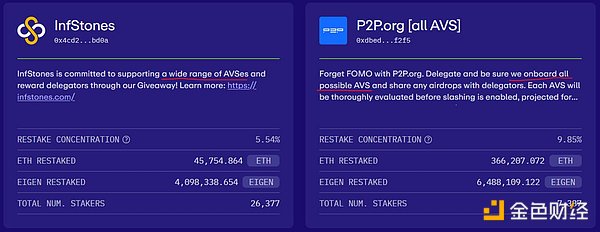
This state of competition can create a bad outcome that no one wants: every node operator validates an AVS that they believe is infallible. When AVS is interrupted and a slashing event occurs, no matter which operator Bob chooses, he will be affected.
3. Understand Mellow Finance
Mellow solves this problem (to some extent). Mellow, also known as "modular LRT", is the middleware of the re-staking technology stack
(middleware) layer, providing a customizable liquidity re-pledge vault. With Mellow, anyone can become their own Ether.Fi or Renzo and build their own LRT vault. These third-party “managers” on Mellow will have full control over which re-pledged assets are accepted, and users will then select assets based on their risk appetite and pay a fee for doing so.

Here is a ridiculous example: Alice is a big fan of DOGE, and she is investing in DOGE to seek income. She saw a vault called DOGE4LYFE on Mellow. She deposits her DOGE into this DOGE4LYFE vault, gets the restaking proceeds, she pays a small fee to the operator and gets LRT called rstDOGE, which she can then use as DeFi collateral elsewhere. This is currently not possible because DOGE is not in EigenLayer's whitelist. Even if EigenLayer founder Sreeram turns his attention to DOGE, the previously mentioned problem of inconsistent incentives faced by node operators still exists.
If this all sounds familiar, that’s because similar services have emerged in the DeFi lending space, such as Morpho, Gearbox, or (DeFi veterans from the last cycle may remember) the now-deprecated Fuse developed by Rari protocol. Take Morpho, for example, which allows the creation of lending vaults with custom risk parameters. This allows users to borrow assets from vaults with unique risk profiles, rather than the one-size-fits-all risk lending pools on Aave. In the upcoming V4 upgrade, Aave also plans to use a separate lending pool to upgrade the protocol.
4. Mellow x Symbiotic x Lido strategy
Since Mellow is just a middleware re-staking protocol, the assets it holds in the vault must be re-staking somewhere. Interestingly, Mellow did not align strategically with EigenLayer, but chose the upcoming re-staking protocol Symbioti. Symbioti is supported by Lido’s venture capital firm cyber•Fund and Paradigm (Paradigm also supports Lido).
Unlike EigenLayer or Karak, Symbiotic supports multi-asset deposits of any ERC-20 token, making it the most permissionless token to date. From ETH to meme coins, any asset can be used as rehypothecated collateral to secure AVS. This could open the door to the worst crypto degeneration: imagine a Symbiotic AVS secured by rehypothecated DOGE collateral.
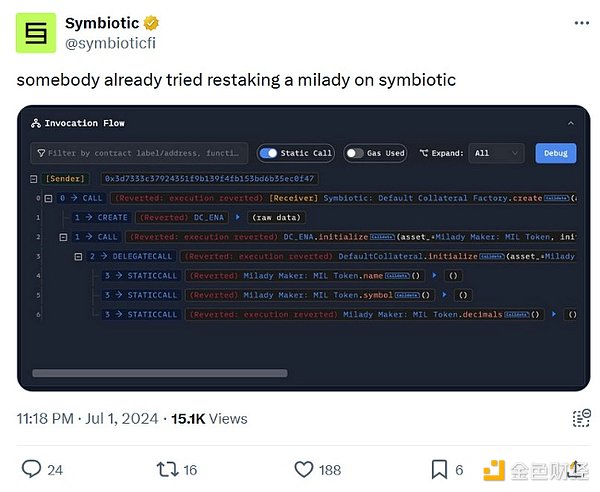
While this is all technically possible, it ignores the modular nature of Mellow's product, which allows for unlimited composability of designs by third-party vault managers. Here, the rationale for Mellow’s integration with Symbiotic becomes clear, as the assets can still be used on other restaking protocols such as EigenLayer or Karak.
So far, many managers have opened their own LRT vaults on Mellow. Unsurprisingly, given Lido’s close partnership with Mellow (more on that later), most managers will hold stETH as collateral.
The exception is Ethena's two vaults which accept sUSDe and ENA. Indeed, Mellow has accomplished an amazing feat – its first sUSDe vault is already full.
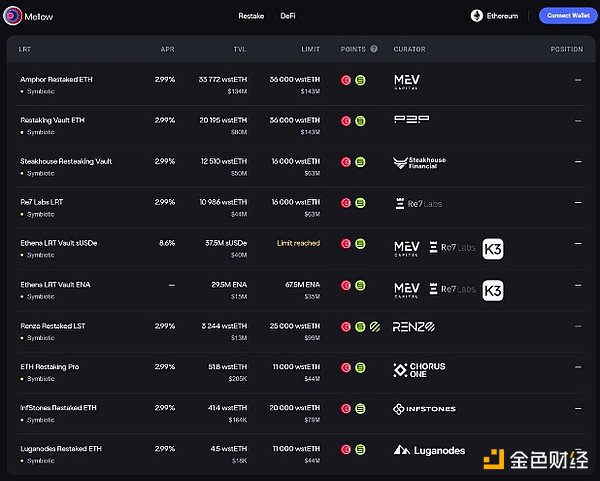
The final step in Mellow's strategy is participation in the recently announced "Lido Alliance", an official association of Lido projects. Mellow benefits from Lido’s stETH direct deposit channel, which explains why it has committed 10% of its MLW token supply (100B) to promoting the partnership. Lido, on the other hand, also benefits from this as it attempts to recapture stETH capital from liquidity re-staking competitors. Lido’s growth has been stagnant since restaking took hold in 2024 as liquidity was taken away by LRT competitors.
5. Market traction
Symbiotic's competitive advantage over EigenLayer or Karak comes from its tight integration with Lido. The core idea is that Lido node operators can issue their own LRT via Mellow/Symbiotic and internalize an additional wstETH yield layer within the Lido ecosystem, thereby returning value to the Lido DAO.
Depositing stETH into a Mellow vault now earns four additional layers of benefits on top of the corresponding vault’s LRT tokens:
· stETH APY
· Mellow Points
· Symbiotic Points
· Re-staking APY (after AVS runs on Symbiotic)
In less than two weeks since Symbiotic opened deposits, it has accumulated $316 million in TVL.
· Symbiotic TVL
The total locked value of assets in USD and ETH on Symbiotic (including all chains) is as follows:

Mellow, on the other hand, has a TVL of $374. Both of these are pretty early positive signs that Lido is going to make a difference here.
· Mellow LRT TVL
The total locked value of assets (liquidity restaking tokens) denominated in USD and ETH on Mellow (including all chains) is as follows:

As of June 20, four Mellow pools have been released on Pendle:
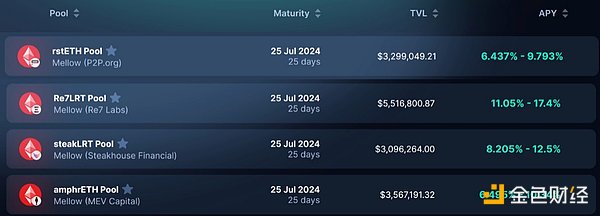
Currently, only Mellow points are eligible for these pools until the Symbiotic cap is increased. To compensate, Mellow rewards 3x points on deposits (or 1.5x points if you deposit directly on Mellow). Given the extremely short expiration dates, the liquidity in these pools is also quite low, so if you try to buy YT, the slippage will be quite high. The best strategy right now is probably PT Fixed Yield, which is a pretty high yield with an APY of 17%-19% across all four vaults.
6. Overview of the re-pledge ecological landscape
The restaking battlefield is getting more and more complex, so let’s give a brief summary. As of today, there are three main re-pledge platforms. Sorted by TVL: EignLayer, Karak, Symbiotic.
· Re-pledge Agreement TVL
The total value of locked assets on EigenLayer, Karak and Symbiotic (including all chains) is as follows:
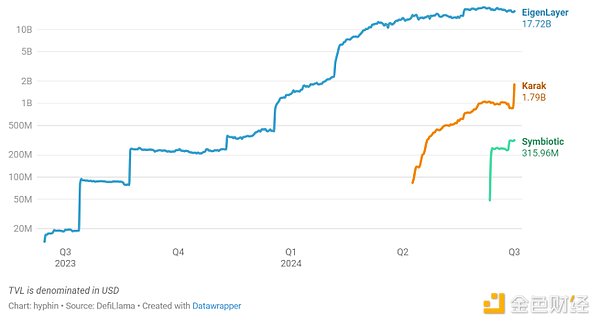
All three restaking platforms offer to sell security to AVS. Given ETH’s dominance and deep liquidity, stETH becomes the obvious choice for EigenLayer’s collateral. Karak has expanded the rehypothecation collateral range from ETH LST to stablecoins and WBTC collateral. Now, Symbiotic is pushing the envelope by supporting the use of any ERC-20 collateral.
At the same time, LRT protocols like Ether.Fi, Swell, and Renzo saw an opportunity and began to compete with Lido with their respective points activities.
· Liquidity re-pledge token TVL
The total value of assets locked in the liquidity re-hypothecation protocol (including all chains) so far this year is as follows:
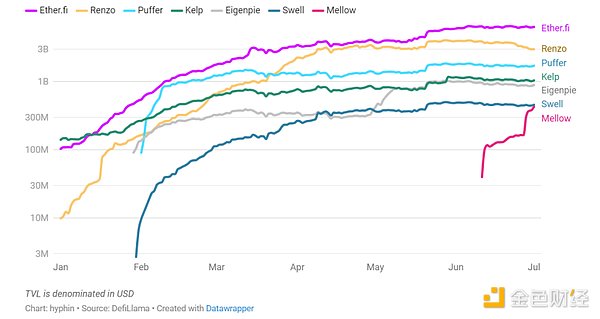
Lido has always enjoyed stETH dominance in the DeFi space, but this time it started losing market share, which went to the LRT protocol. For Lido, the simple response might be to strategically position stETH from LST to an LRT asset. But the reality is that Lido still uses stETH as LST, but will cultivate its own re-staking ecosystem while retaining stETH. To this end, Lido is strongly supporting Symbiotic and Mellow to become part of the "Lido Alliance" to provide a permissionless modular re-staking product. The sales strategy is summarized as follows:
· Dear token-owning projects, don’t wait for EigenLayer to whitelist your token, come to Symbiotic and publish your own LRT in a permissionless manner.
· Dear users, don’t save your wstETH with LRT competitors anymore, give it to Mellow, you can get better risk-adjusted returns.
7. Conclusion
As competition in the re-pledge field becomes increasingly fierce, the following points are worth thinking about:
· How big is the demand for re-staking AVS? Do we really need so many re- staking players? As of today, live AVS is only available on EigenLayer. TVL is approximately 5.33 million ETH, and a total of approximately 22.6 million ETH is re-pledged in 13 AVS at a mortgage rate of approximately 4.24 times.
· The main trend among re-staking platforms is the race to integrate as many assets as possible to support re-staking. Late comers, competitors like Karak, are trying to differentiate themselves from other competitors by using WBTC collateral, stablecoins, and Pendle PT assets. Symbiotic goes a step further, allowing the use of any ERC-20 token but leaving asset management to third- party Mellow vault creators. Despite the strictest restrictions, EigenLayer still maintains a huge lead in TVL. Additionally, the jury is still out on whether allowing non-ETH assets for chain security is a wise move.
· What does this mean for the LRT protocol? To be sure, nothing prevents them from making similar integrations with Symbiotic, and in fact Renzo has already done so. Not only is Symbiotic designed to support maximum permissionless features, the LRT protocol has no reason to be loyal to EigenLayer, and before Mellow can gain a monopoly in the secondary market, the LRT protocol will want to gain in Lido's restaking ecosystem. a certain market share. However, is there serious competition? As mentioned above, Lido aims to reassert its stETH dominance, while Symbiotic and Mellow are both projects backed by the liquidity staking giant. This goal fundamentally conflicts with Symbiotic eETH, ezETH, and swETH considerations. It will be interesting to see how Lido weighs the pros and cons.
· From a builder’s perspective, it becomes increasingly easier to bootstrap the economic security of your own chain. EigenLaye makes it easy and convenient, but the permissionless vaults in the Mellow x Symbiotic ecosystem are taking it a step further to make it even more convenient. Major players like Ethena have announced plans to support sUSDe and ENA restaking in Symbiotic to secure their own upcoming Ethena Chain release, rather than expecting EigenLayer or Karak to whitelist ENA as a restaking collateral.
· What does this mean for Lido DAO and LDO token holders? The DAO charges a 5% fee on all stETH staking rewards, which are split between the node operators, the DAO and the insurance fund, so staking more ETH in Lido (rather than the LRT protocol) means more revenue for the DAO . However, whether Lido is building its own re-pledge ecosystem or the LDO token itself, there is no clear path for value accumulation. LDO is still just a governance token.




 panewslab
panewslab
 chaincatcher
chaincatcher